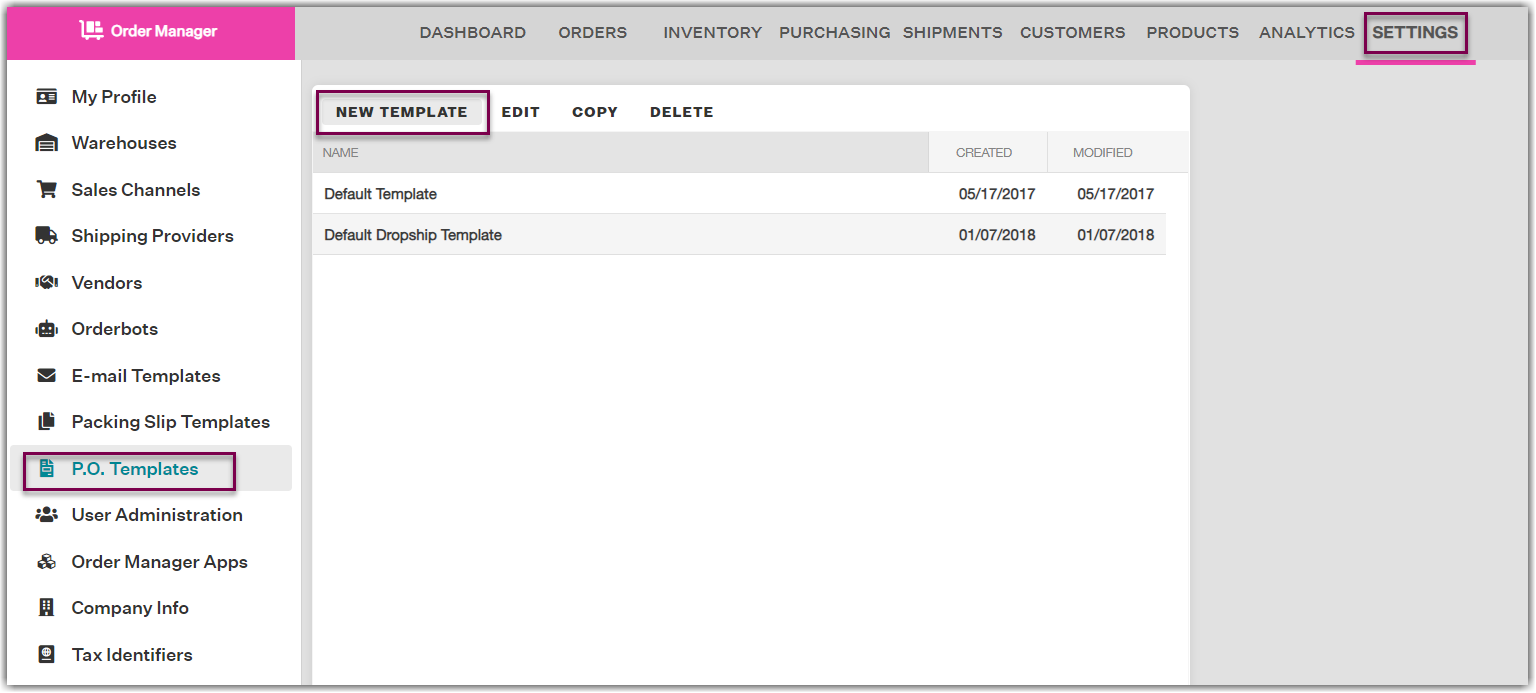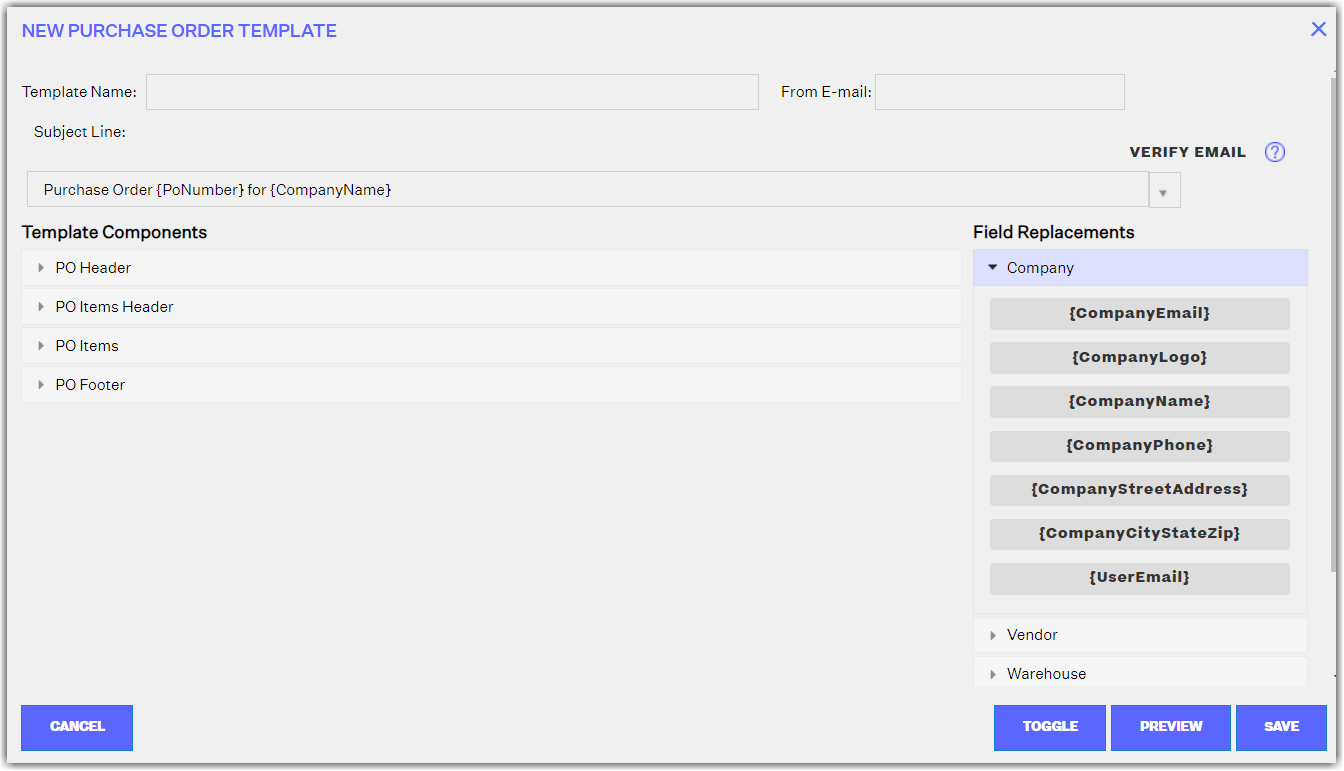-
Settings
-
General
- Configuring Shipping Presets
- Update My Profile
- Disable the Inventory Update From Extensiv Order Manager to All Sales Channels
- How to Enable Out of Stock Control for eBay Sales Channels
- Company Info and Additional Account Settings
- Installing an App from the Order Manager App Store
- How to View Your Extensiv Order Manager Invoices
- How To Remove an App in Order Manager
- Ruby Has 3PL Integration
- Company Time Zone Setting
- Tax Identifiers
-
Sales Channels
- Deactivating a Sales Channel
- Editing Sales Channels
- Enable or Disable Extensiv Order Manager Email Notifications to Your Customers
- Shopify Tags
- Shopify Locations
- Amazon Cancellation Settings
- Steps in Adding Walmart as a Sales Channel
- Adding Newegg as a Sales Channel
- Adding eBay as a Sales Channel
- Viewing a Sales Edit Channel's History
- Reactivating Sales Channels
- Adding Amazon as a Sales Channel
- Adding Shopify as a Sales Channel
- Adding a Manual Sales Channel
- Adding Sales Channels
- Assigning a Packing Slip and/or Email Template to your Sales Channel
- How to Exclude a Warehouse From Pushing Inventory to a Sales Channel
- Setting Up Shipment & Carrier Mappings for Your Sales Channels
- Amazon Pacific Time Orderbot Setting
- Walmart Fulfillment Services - WFS
- WFS Workflow
-
Webhooks
- Order Creation Webhook
- Shopify Cancellation Webhook
- Shopify Refund Webhook - POS Orders
- Shopify Fulfillment Webhook
- Shopify Refund Webhook (e-commerce Orders)
- Shopify Product Deletion Webhook
- BigCommerce Webhook
- Shopify Product Update / Product Edit Webhook
- Shopify Auto-Subscribing Webhooks
- Order Payment Webhook
-
Shipping Providers
- Adding FedEx as a Shipping Provider
- How to Add Express 1 as a Shipping Provider
- Adding Amazon Buy Shipping as a Shipping Provider
- UPS Mail Innovations Services
- Adding DHL eCommerce as a Shipping Provider
- FedEx ETD
- Deactivate or Reactivate a Shipping Provider
- Adding Shipping Providers
- Customizing Shipping Services and Package Types Per Shipping Provider
- Vendors
-
Warehouses & Vendors
- Creating and Configuring Warehouses in Extensiv Order Manager
- Can I have additional order information populated on my Shipping label?
- Configuring Shipping Label Print Format Options
- Inventory Dependent Warehouses
- How to Configure the Order Export File for FTP Connections
- Deactivating a Warehouse in Extensiv Order Management
- Updating the Address/Return Address for Your Warehouse
- Search for Vendors
- Configuring a Dropship Vendor
- Creating an In-House Warehouse
- How do I connect Extensiv Order Manager with Deliver?
- Configuring Dropship Vendor FTP
- FTP Inventory Import for a 3PL
- Setting Up Domestic Backup Warehouses
- Setting Up a Warehouse's International Rank
- Pick List Settings
- Setting Up a 3PL Warehouse
- Setting Up Document Print Settings
- Setting a Dropship Template and Fulfilling Orders with a P.O.
- Use Component Inventory Setting for Bundles and Kits
- Instructional Video - Creating Warehouses & Warehouse Settings
-
Orderbots
- Orderbots - Complete List of Filters & Actions
- Postal Zones in Extensiv Order Manager
- Automating Orders to Fulfill from a Specific Warehouse
- Editing an Orderbot
- Deactivating an Orderbot in Extensiv Order Manager
- Mark Order as Shipped Orderbot
- Replace Address Orderbot
- Creating an Orderbot
- Support for Shopify's Additional Details
- Orderbots filtered by zip code range
- Adding Order Item to Order Orderbot Action
- Commonly Used Orderbots
- Understanding Apply Best Rate vs Cheapest Rate Orderbots
- Orderbot: Set order weight and dimensions based on products
- Orderbot: Using Hold the order for and Mark Order as Shipped
- Templates
-
General
Setting up Purchase Order (PO) Templates
Overview
This article provides a step by step guide on setting up PO templates in Order Manager.
How-to Guide
The purchase order template generated when sending and authorizing a P.O. can be customized. Once completed, vendors can share a common template or users can create specific P.O. templates per vendor.
- To begin, go to the Settings module and click on the P.O Templates tab from the left-side menu. Every account comes pre-loaded with a default template that cannot be edited or deleted. These defaults are basic guides that can help you start creating a custom template, or can be used as they are.
- To begin customizing a basic PO Template, click on + New Template.
 Otherwise, you can highlight the Default Dropship Template row and click Copy to customize a PO template specifically for dropship vendors.
Otherwise, you can highlight the Default Dropship Template row and click Copy to customize a PO template specifically for dropship vendors. - In the topmost row of the new window, you can give your new template a unique name. Users can also change the FROM email address so that the PO appears to be coming from a specific e-mail address instead of the default email by specifying the desired address in the text field in the top right.

- PO templates are split up into 4 main components:
- PO Header
- PO Items Header
- PO Items
-
PO Footer
You can choose to edit existing static and dynamic text. To insert dynamic fields into the template, first click on where you want to place them in the template on the left side, then click on the desired Field Replacements on the right.
The field replacements options here are split into six sections:- Company
- Vendor
- Warehouse
- Purchase Order
- PO Items
-
Barcode Imag
All of the field replacements are optional. Users can customize their own set-up within each section by using field replacement options and/or static text. Relevant information will be shown on a PO form at the time of its generation.
- For more advanced users, the templates support editing via HTML by clicking the <> Toggle button at the bottom of the window. Field replacements will insert using the {bracket} syntax into this view as well.
- These templates can be previewed by clicking on the Preview button in the bottom-right menu bar. Below is an example of a PO Template Preview where the Company Logo is populated.
Please note: not all dynamic field replacements will populate text or images in the preview generated as it would need to be connected to an actual purchase order for the preview to pull all relevant fields that exist in the PO. - Click Save after making all desired edits. Saved templates can be modified later by selecting then clicking Edit in the P.O Templates tab. At this point, you can set your new PO template as the default template for a Vendor in the PO Defaults section of Vendor information, use it in orderbots, and/or set it as the template for a specific PO in the POs module.
There is no limit to the number of templates you can create within an account.
 | Help Center
| Help Center
